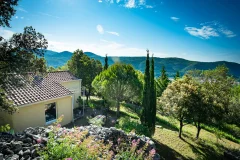Alsace Description and Information
Alsace Départements
- Bas-Rhin (67)
- Haut Rhin (68)
Alsace Description and Information
Diverse Landscapes
Alsace is situated in the far north-east corner of France and is one of the country's smallest régions. This beautiful and enchanting area nestles between the Vosges mountains to the west and the river Rhine, which forms a long natural border with Germany, to the east. The picturesque countryside is a mix of dense forests, rich farmland, pretty vineyards, fortified towns and quaint villages of half-timbered houses with geranium-filled window-boxes.
Many of these villages can be found on the Route de Vin which undulates for 112km along the foothills of the Vosges mountains. Summer is a good time to visit for those who enjoy Alsation wines such as Riesling and Muscat, as a wine festival is held every weekend in a different town. Another scenicarea, with its gentle rounded mountains and glacial lakes, is the 3000km2 national park, the Massif de Vosges. The lush Vallée de Munster, home of the town Munster and its eponymous cheese, is a walker's paradise.
A Big Historical Heritage
Alsace has often been positively described as the gateway between Latin and Germanic cultures, but its border proximity has more often than not been a millstone around the necks of the natives. In the past century, Alsations saw their région annexed twice by the Germans, first from 1870 to 1918 and then again from 1940 to 1944.
Even though much of the architecture, cuisine, dress and dialect is Germanic in style and the stereotype of the people matches that often held of the Germans (that is, well-organised, hard-working and tax-paying) nationalism here is rife. The people see themselves as French, but first and foremost as Alsations. As a result of this pride, the use of their régional language has remained strong. It is spoken by four out of ten inhabitants and, although passing on less from parent to child, it has reoccurred on shop signs and menus. Known as Elässisch, this High German dialect, is spoken all over the région and by all ages, but is not taught in schools and rarely written.
Alsace Property Market
Property prices are higher than average in this région and fewer derelict properties are to be found as, unlike in many régions, there has never been a mass exodus from cities and farms. The styles of the houses are stone and half timbered, many painted. Steep-pitched roofs and dormer windows are characteristic of the région. Towns such as Sauverne and Wissembourg are built in the local red sandstone.
Come and Live in Alsace
Outsiders are attracted to the région for its education, cultural and economic opportunities. It's a good place to move if you're looking to stay permanently and find work. It has a relatively young population, with low unemployment.
Many types of industry are represented and Strasbourg is a very important European administrative centre. Many people in this city also work in the banking sector. The région is a good place to base a business because it has excellent road connections and high speed TGV links to Paris (500km), and links to Frankfurt in Germany and Basel and Zurich in Switzerland.
Agriculturally, other than the vineyards, the important crops are maize, cauliflowers, mirabelles, and quetsches (an Alsatian plum often made into brandy and delicious served warm in a coffee mug). Beer is also very important to the région's economy, and the famous bottled beer Kronenbourg is produced here.
Alsace Population
- Population: 1,734,145
- Pop.density (people per km2): 209









